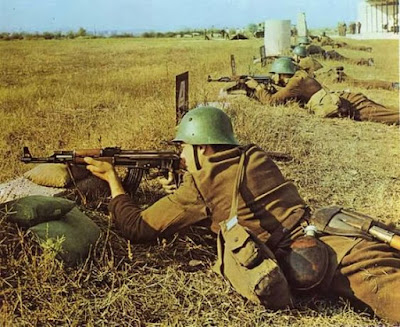The company I bought the previous pickaxe from, went ahead and sent me another pick as compensation for a "product not as advertised", (it was supposed to be "like new"). As you will see in the photos, this replacement pickaxe was not anything close to new, but it was in much better condition than the first one I received! And besides, how could I possibly complain when I got two for the price of one!
It appears that this new pick is a combination of an older pick head, and a newer replacement handle. The pick itself appears to have been in this configuration for quite some time, and based on the wood, I would imagine the handle was replaced some during the Cold War era.
I have no way to know for sure, but I suspect that the pick head dates back to the WW1 or WW2 era.
I have talked about these picks in my previous Bulgarian Pickaxe posting, so I won't repeat myself here. You can read more here in my first posting:
http://sharky-fourbees.blogspot.com/2016/09/bulgarian-military-pick-axe-pick.html
Before we get too far along, I'd like to show some photos of both of these pickaxes, side-by-side. The New pickaxe is on the left, and the much older, first pickaxe, is on the right.
When I received this "new" pickaxe, it was covered in the old "Com-Block" hard tar preservative. This hard tar coating was usually applied before these tools were placed into long-term storage.
After an hour or so of soaking and scrubbing with a scouring pad and mineral spirits, It had all of the surface tar removed. There is always a residual amount that has soaked into the wood, but I think that gives it a great "vintage look" and still lets it retain some of its Cold War history. You can see the contrast with the "old" pickaxe that was never preserved.
I finished off the wood handle with some teak oil and let everything dry out well. The finish turned out great!
I also did some restoration work on the "old pickaxe" from my first posting.
As you may recall, the wood on the handle was damaged from post beetles and there was some dry rot. I used a penetrating polyurethane and saturated all the wood until it would not soak up any more of the poly. I used a syringe to slowly inject polyurethane into each post beetle hole to fully saturate the interior of the wood. By injecting the polyurethane into the holes, I preserved, and sealed any rot inside the handle. It took about 1/4 cup to reach maximum saturation. The handle turned out a bit darker than it was originally, but at least now it is fully preserved and strengthened. I left the metal head untouched. For an old pickaxe that is probably near 100 years old, it now has a new lease on life!
Here are a few shots of the restored "old pickaxe"......... As a "before and after" comparison, you can hop back over to the first post to see the "before" shots.
http://sharky-fourbees.blogspot.com/2016/09/bulgarian-military-pick-axe-pick.html
As an interesting comparison, lets take a look at three photos from the the three eras that these old picks were used, WW1, WW2 and the Cold War. In the first photo, you will see one of these old picks being carried on the belt of the soldier closest to us, with his back towards us. The soldier to the left and in front of him, is carrying a "trench spade" on his belt. This is the only photo that I have been able to find that shows one of these picks in use.
 |
| World War One |
 |
| World War Two |
 |
| Cold War |
Now let's take a closer look at this new Pick Axe. Enjoy.



